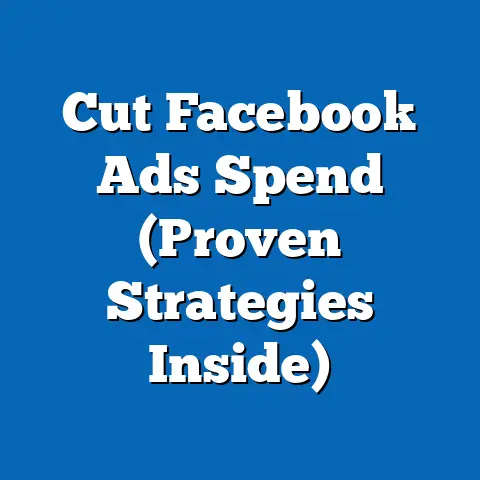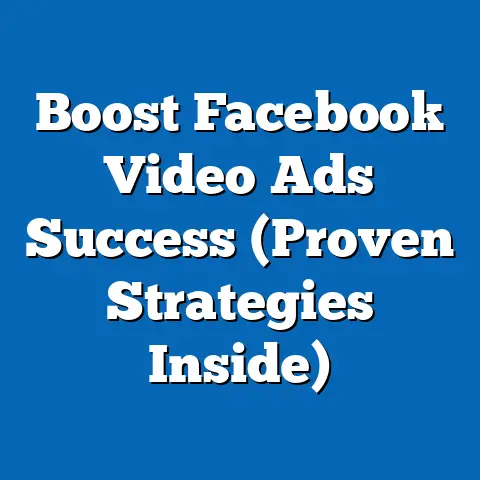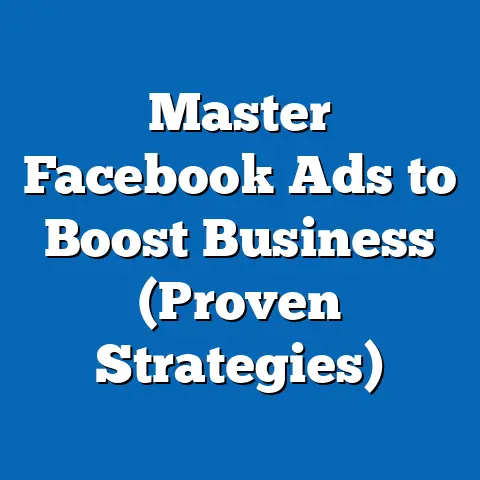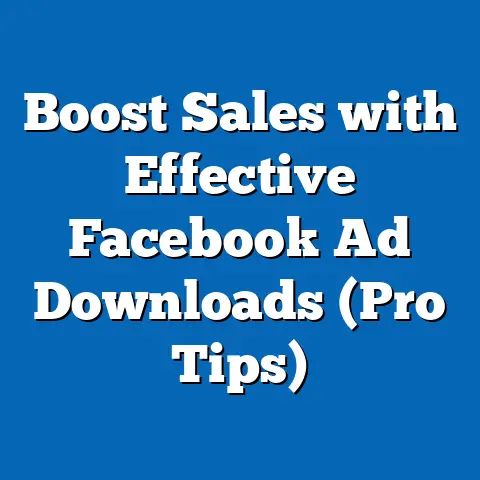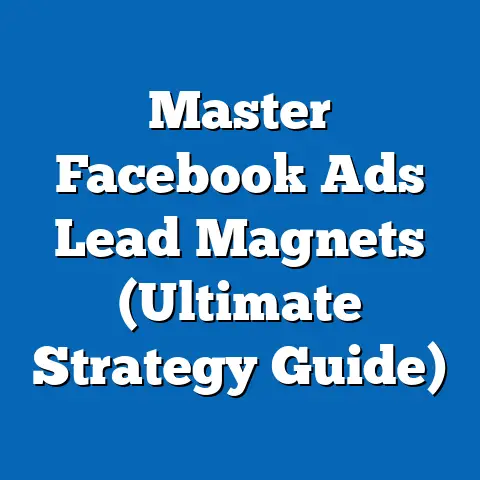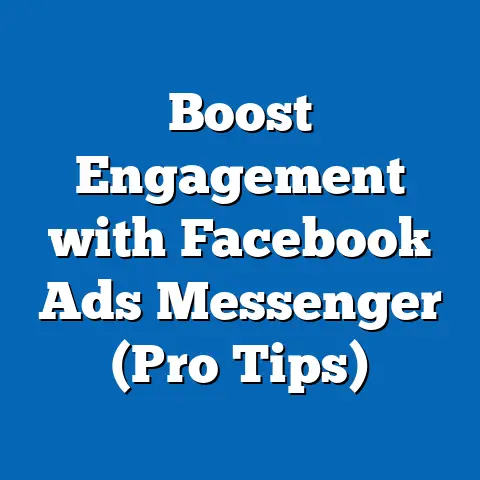Optimize Facebook Ad Images for Higher Engagement (Pro Tips)
In today’s world, where environmental concerns are at the forefront, brands are increasingly recognizing the importance of sustainability. This awareness isn’t just a trend; it’s a fundamental shift in consumer expectations. As a digital marketing specialist, I’ve seen firsthand how businesses that authentically embrace eco-friendly practices gain a significant edge. This extends to every facet of their operations, especially their advertising. When it comes to Facebook ads, the visuals you use can speak volumes about your brand’s commitment to the environment.
Think about it: consumers are bombarded with ads daily. They’re scrolling through their feeds, often on autopilot. To cut through the noise, your ads need to grab their attention, and more importantly, resonate with their values. That’s where eco-friendly visuals come in. By optimizing your Facebook ad images not just for aesthetics but also for promoting a green message, you can tap into a powerful connection with your target audience.
Consider these statistics: studies have shown that a significant percentage of consumers are willing to pay more for products and services from companies committed to positive social and environmental impact. This means that incorporating eco-friendly visuals into your Facebook ads isn’t just about being trendy; it’s about aligning with your audience’s values and potentially boosting your bottom line.
Section 1: Understanding the Importance of Visuals in Facebook Advertising
In the fast-paced world of social media, visuals reign supreme. On platforms like Facebook, where users are constantly scrolling, images have the power to capture attention in a fraction of a second. As I’ve learned over years of running campaigns, text alone often isn’t enough to make a lasting impression.
Why are visuals so crucial? Because they communicate instantly. An image can convey a message, evoke an emotion, and tell a story much faster than words. This is especially relevant when you’re promoting eco-consciousness. Imagine trying to describe the beauty of a pristine forest or the impact of plastic pollution in words. It simply doesn’t have the same impact as a well-chosen photograph or video.
This is where visual storytelling comes into play. Effective imagery can create a strong emotional connection with your audience, particularly when you’re promoting sustainability. When I worked with a local organic farm, we used images of their vibrant produce, happy farmers, and lush fields. These visuals weren’t just pretty; they told a story about their commitment to sustainable agriculture and their connection to the land. The response was incredible. People felt a connection to the farm and were eager to support their mission.
Think about the last time you saw a powerful image related to environmental issues. Did it make you stop scrolling? Did it make you think differently about your choices? That’s the power of visual storytelling. When you use images that resonate with your audience’s values and emotions, you’re more likely to capture their attention, build trust, and drive engagement.
Key Takeaway: Visuals are essential in Facebook advertising because they communicate instantly and create emotional connections. They’re especially powerful when promoting eco-consciousness because they can tell a story and evoke feelings that words alone can’t capture.
Section 2: Key Elements of High-Performing Facebook Ad Images
Creating high-performing Facebook ad images isn’t just about aesthetics. It’s about understanding the key elements that make an image effective and how to use them to promote your eco-conscious message. I’ve found that the most successful images share three common characteristics: clarity, relevance, and branding.
- Clarity: Your image should be clear and easy to understand. Avoid cluttered or confusing visuals that can distract from your message. When I’m reviewing ad images, I always ask myself, “Can someone understand what this ad is about in a single glance?” If the answer is no, it’s time to simplify.
- Relevance: Your image should be relevant to your product, service, and target audience. It should also align with your eco-conscious values. If you’re promoting a sustainable clothing brand, for example, use images that showcase your clothing made from eco-friendly materials, worn by people who embody your target audience’s values.
- Branding: Your image should reflect your brand’s identity and values. Use your brand colors, fonts, and logo in a subtle but effective way. This helps to create a consistent brand experience and reinforces your brand’s commitment to sustainability.
In the context of eco-consciousness, it’s crucial to choose images that reflect sustainable practices. This could include images of:
- Renewable energy sources like solar panels or wind turbines
- Eco-friendly products made from recycled or sustainable materials
- Nature-focused themes that showcase the beauty and fragility of the environment
- People engaging in sustainable activities like recycling, planting trees, or using public transportation
I once worked with a company that sold eco-friendly cleaning products. They initially used stock photos of generic cleaning supplies in their ads. The results were underwhelming. When we switched to images of their products being used in real homes, with a focus on natural light and sustainable living, their engagement skyrocketed. People responded to the authenticity and the visual representation of their eco-conscious values.
The psychology behind color choices also plays a significant role. Certain colors can evoke feelings of trust and environmental responsibility. Green, for example, is often associated with nature, growth, and sustainability. Blue can evoke feelings of trust, stability, and cleanliness. When I’m selecting colors for ad images, I always consider the emotions I want to evoke and how those colors align with my brand’s message.
Key Takeaway: High-performing Facebook ad images are clear, relevant, and branded. When promoting eco-consciousness, choose images that reflect sustainable practices and consider the psychology behind color choices to evoke feelings of trust and environmental responsibility.
Section 3: Best Practices for Optimizing Facebook Ad Images
Optimizing your Facebook ad images is crucial for maximizing engagement and reaching your target audience. As I’ve learned through trial and error, there are several key best practices that can make a significant difference.
Image Size and Dimensions
Facebook offers a variety of ad formats, each with its own recommended image sizes and dimensions. It’s essential to ensure that your images are optimized for the specific ad format you’re using. Using the wrong size can result in blurry images, cropped content, or a poor user experience.
Here are some general guidelines:
- Single Image Ads: Recommended size is 1200 x 628 pixels.
- Carousel Ads: Recommended size is 1080 x 1080 pixels.
- Stories Ads: Recommended size is 1080 x 1920 pixels.
I always recommend using high-resolution images to ensure they look sharp and professional on all devices. Facebook recommends a minimum resolution of 1080 x 1080 pixels for most ad formats.
Text Overlay
Including text on your images can be a great way to highlight key messages and calls to action. However, it’s important to maintain a balance and avoid overwhelming the visual aspect of your ad. Facebook used to have a strict “20% text rule,” which limited the amount of text you could include on your images. While this rule is no longer in effect, it’s still a good idea to keep your text concise and visually appealing.
Here are some best practices for including text on images:
- Use a clear and readable font: Choose a font that is easy to read, even at small sizes.
- Keep the text concise: Focus on the most important message and avoid long paragraphs.
- Use contrasting colors: Ensure that your text stands out against the background of your image.
- Place the text strategically: Position the text in a way that complements the visual elements of your image.
When promoting eco-conscious themes, it’s important to maintain a balance that resonates with your audience. Avoid using overly promotional or salesy language. Instead, focus on highlighting the benefits of your eco-friendly products or services in a clear and authentic way.
Use of Authentic Imagery
In today’s world, consumers are increasingly skeptical of traditional advertising. They’re looking for authenticity and transparency. That’s why I always encourage the use of real images over stock photos, particularly those that showcase genuine eco-friendly practices.
Stock photos can often feel generic and impersonal. They may not accurately reflect your brand’s values or your commitment to sustainability. Real images, on the other hand, can help to build trust with your audience and create a more authentic connection.
Here are some examples of authentic imagery you could use in your Facebook ads:
- Photos of your team engaging in sustainable activities like recycling or volunteering for environmental causes.
- Images of your products being made using eco-friendly materials and processes.
- Photos of your customers using your products in their daily lives.
- Images of the natural environment that your brand is committed to protecting.
When I worked with a local coffee shop that was committed to sustainability, we used images of their baristas using reusable cups, their coffee beans being sourced from sustainable farms, and their customers enjoying their coffee in a relaxed and eco-friendly atmosphere. These images were authentic, relatable, and helped to build a strong connection with their target audience.
Key Takeaway: Optimize your Facebook ad images by using the correct sizes and dimensions, maintaining a balance with text overlay, and using authentic imagery that showcases your commitment to eco-friendly practices.
Section 4: The Role of A/B Testing in Image Optimization
A/B testing is a crucial part of any successful Facebook advertising strategy. It allows you to test different versions of your ads to determine what resonates best with your target audience. When it comes to image optimization, A/B testing can help you to identify the most effective visuals for driving engagement and achieving your marketing goals.
I’ve seen firsthand how A/B testing can lead to significant improvements in ad performance. For example, I once worked with an online retailer that was struggling to generate sales with their Facebook ads. We decided to A/B test different images to see what would resonate best with their target audience. We tested images with different styles, colors, and messaging.
The results were surprising. We found that images with a more natural and authentic look performed significantly better than those with a polished and professional look. We also found that images that highlighted the benefits of their products in a clear and concise way generated more clicks and sales.
Here are some examples of what you can A/B test when it comes to image optimization:
- Different styles: Test images with different styles, such as photos, illustrations, or graphics.
- Different colors: Test images with different color schemes to see what evokes the desired emotions and responses.
- Different messaging: Test images with different text overlays to see what messages resonate best with your audience.
- Different compositions: Test images with different compositions to see what is most visually appealing and effective.
When conducting A/B tests, it’s important to focus on testing one variable at a time. This allows you to isolate the impact of each variable and determine what is truly driving performance. It’s also important to run your tests for a sufficient amount of time to gather enough data to make informed decisions.
To interpret the results of your A/B tests, focus on key metrics such as:
- Click-through rate (CTR): This measures the percentage of people who saw your ad and clicked on it.
- Conversion rate: This measures the percentage of people who clicked on your ad and completed a desired action, such as making a purchase or filling out a form.
- Cost per click (CPC): This measures the cost you pay each time someone clicks on your ad.
- Return on ad spend (ROAS): This measures the revenue you generate for every dollar you spend on advertising.
By analyzing these metrics, you can identify which images are performing best and use that information to optimize your future ad campaigns.
A/B testing can also help you to support your eco-conscious brand image. By testing different images that highlight your commitment to sustainability, you can identify the visuals that resonate most with your target audience and reinforce your brand’s values.
Key Takeaway: A/B testing is essential for image optimization. Test different styles, colors, and messaging to identify the visuals that resonate best with your target audience and support your eco-conscious brand image.
Section 5: Leveraging User-Generated Content for Authentic Engagement
In today’s digital landscape, user-generated content (UGC) is a powerful tool for creating authentic connections with consumers. As I’ve learned, people trust the opinions and experiences of other consumers more than they trust traditional advertising. That’s why leveraging UGC in your Facebook ads can be a highly effective way to boost engagement and build trust.
UGC refers to any content – such as images, videos, or reviews – created by your customers or fans. This content is often seen as more authentic and trustworthy than branded content because it comes from real people who have experienced your products or services firsthand.
When it comes to promoting eco-consciousness, UGC can be particularly effective. Customers who are passionate about sustainability are often eager to share their experiences with eco-friendly products or services. By encouraging them to share their own images involving your products or services while promoting sustainability, you can tap into a valuable source of authentic content.
Here are some tips on how to encourage customers to share their own images:
- Run a contest or giveaway: Encourage customers to share their images for a chance to win a prize.
- Create a hashtag: Create a unique hashtag that customers can use when sharing their images on social media.
- Feature customer images on your website and social media channels: This shows customers that you value their content and encourages others to share their own images.
- Partner with influencers: Collaborate with influencers who are passionate about sustainability to create and share content featuring your products or services.
Once you’ve gathered a collection of UGC, you can incorporate it into your Facebook ads for enhanced engagement. Here are some ways to do that:
- Create carousel ads: Showcase multiple customer images in a carousel ad.
- Use customer images in single image ads: Replace stock photos with authentic customer images.
- Create video ads: Compile customer videos into a compelling video ad.
- Feature customer testimonials: Include customer testimonials in your ad copy.
When curating and incorporating UGC into your Facebook ads, it’s important to:
- Obtain permission: Always ask for permission before using customer images in your ads.
- Give credit: Give credit to the original creators of the content.
- Maintain quality: Choose high-quality images that are visually appealing and relevant to your brand.
- Ensure authenticity: Avoid using images that look staged or overly promotional.
By leveraging UGC in your Facebook ads, you can create a more authentic and engaging experience for your target audience. This can lead to increased brand awareness, trust, and ultimately, sales.
Key Takeaway: Leverage user-generated content to create authentic connections with consumers. Encourage customers to share their own images and incorporate this content into your Facebook ads for enhanced engagement.
Section 6: Analyzing Engagement Metrics to Fine-Tune Image Strategies
Tracking and analyzing engagement metrics is crucial for evaluating the effectiveness of your ad images and making data-driven decisions. As I’ve learned, simply creating visually appealing images isn’t enough. You need to understand how your audience is responding to your ads and use that information to fine-tune your image strategies.
There are several key engagement metrics that you should be tracking:
- Click-through rate (CTR): This measures the percentage of people who saw your ad and clicked on it. A high CTR indicates that your image is capturing attention and driving interest.
- Conversion rate: This measures the percentage of people who clicked on your ad and completed a desired action, such as making a purchase or filling out a form. A high conversion rate indicates that your image is effectively driving conversions.
- Cost per click (CPC): This measures the cost you pay each time someone clicks on your ad. A low CPC indicates that your image is efficiently driving traffic to your website.
- Engagement rate: This measures the percentage of people who interacted with your ad, such as liking, commenting, or sharing it. A high engagement rate indicates that your image is resonating with your audience and sparking conversation.
- Reach and frequency: Reach measures the number of unique people who saw your ad, while frequency measures the average number of times each person saw your ad. Tracking these metrics can help you to understand how your image is performing in terms of brand awareness.
To track these metrics, you can use Facebook Insights and other analytics tools. Facebook Insights provides a wealth of data about your ad performance, including demographics, interests, and behaviors of the people who are interacting with your ads.
When analyzing your engagement metrics, it’s important to set benchmarks for your eco-conscious campaigns. This will help you to understand whether your images are performing well and whether you’re achieving your marketing goals.
Here are some factors to consider when setting benchmarks:
- Industry averages: Research industry averages for key engagement metrics to get a sense of what is considered a good performance.
- Past performance: Analyze your past ad campaigns to identify what has worked well and what hasn’t.
- Campaign goals: Set specific, measurable, achievable, relevant, and time-bound (SMART) goals for your eco-conscious campaigns.
Based on your analysis of engagement metrics, you can adjust your image strategies to improve performance. Here are some examples of how you can do that:
- If your CTR is low: Try testing different images with different styles, colors, and messaging.
- If your conversion rate is low: Ensure that your landing page is optimized for conversions and that your ad copy is clear and compelling.
- If your CPC is high: Try targeting a different audience or adjusting your bidding strategy.
- If your engagement rate is low: Focus on creating images that are more visually appealing and that resonate with your audience’s values.
- If your reach is low: Increase your budget or expand your targeting.
- If your frequency is high: Try refreshing your images or narrowing your targeting.
By continuously tracking and analyzing your engagement metrics, you can fine-tune your image strategies and maximize the effectiveness of your Facebook ads.
Key Takeaway: Track and analyze engagement metrics to evaluate the effectiveness of your ad images. Set benchmarks for your eco-conscious campaigns and adjust your strategies based on data insights.
Conclusion
In conclusion, optimizing your Facebook ad images for higher engagement is essential for any eco-conscious marketer. By understanding the importance of visuals, choosing the right elements, following best practices, leveraging user-generated content, and analyzing engagement metrics, you can create Facebook ads that not only capture attention but also promote your brand’s commitment to sustainability.
Visually appealing, authentic, and sustainable imagery can significantly enhance a brand’s connection with its audience. Consumers are increasingly drawn to brands that share their values, and by showcasing your eco-friendly practices through your ad images, you can build trust, drive engagement, and ultimately, achieve your marketing goals.
As a call to action, I encourage you to embrace eco-friendly practices and continuously refine your strategies for optimal results. Start by auditing your existing Facebook ad images and identifying areas for improvement. Experiment with different styles, colors, and messaging. Leverage user-generated content to create a more authentic experience. And most importantly, track and analyze your engagement metrics to ensure that your images are effectively driving results.
By embracing these principles, you can create Facebook ads that not only generate leads and sales but also make a positive impact on the planet. Remember, every image you share is an opportunity to promote sustainability and inspire others to join you on your eco-conscious journey.

